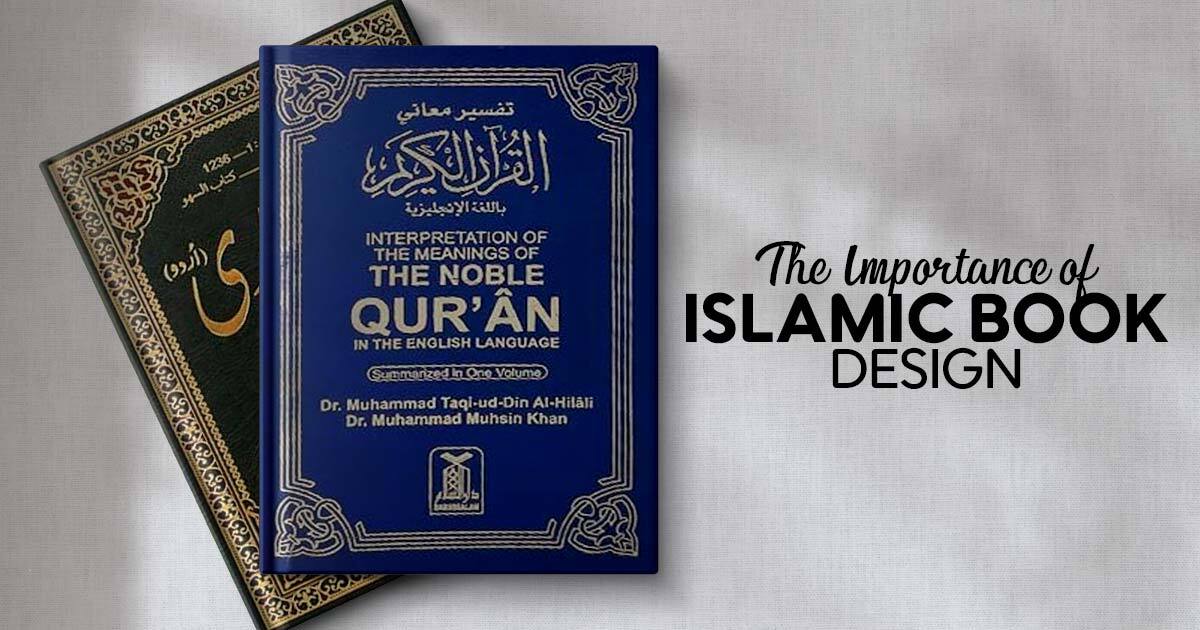In the vast world of Islamic scholarship, the written word holds immense importance. From the sacred text of the Quran to historical accounts and contemporary Islamic thought, books serve as vessels of knowledge and guidance. But the message within an Islamic book isn’t the only element deserving of attention. Islamic book design plays a crucial role in presenting this knowledge with respect, beauty, and functionality.
This blog delves into the significance of Islamic book design, exploring its historical roots, key characteristics, and the impact it has on readers.
A Legacy of Beauty and Functionality:
The tradition of Islamic book design stretches back centuries, reflecting the rich artistic heritage of Islamic civilization. Early Qur’anic manuscripts showcased meticulous calligraphy, intricate geometric patterns, and illuminations that served both aesthetic and practical purposes.
- Emphasis on Clarity: The primary function of Islamic book design has always been to ensure the clear and accurate transmission of knowledge. Calligraphy, the art of beautiful writing, was honed to perfection, with specific scripts developed for the Quran and other religious texts.
- Respect for the Text: The design elements complemented the text, not overpowered it. Borders, illuminations, and flourishes served to enhance the sacred nature of the content while maintaining readability.
- Integration of Islamic Art: Geometric patterns, arabesque designs, and calligraphy itself embodied Islamic principles of beauty and order. These elements instilled a sense of reverence for the knowledge contained within.
Over time, Islamic book design evolved to encompass a wider range of Islamic literature. Historical texts, scientific treatises, and philosophical works all adopted design elements that reflected their genre and importance.
Key Characteristics of Islamic Book Design:
While specific design choices may vary, some core characteristics define Islamic book design:
- Calligraphy: As mentioned earlier, calligraphy remains central to Islamic book design. Scripts like Thuluth, Naskh, and Kufic are commonly used, each with its own aesthetic qualities and level of formality.
- Geometric Patterns: Islamic art is renowned for its intricate geometric patterns. These patterns often adorn borders, chapter headings, and even entire pages, adding visual interest and symbolizing the underlying order and harmony within the universe.
- Illuminations: Traditionally, illuminations were hand-painted illustrations or decorative flourishes that marked significant sections or enhanced the beauty of the manuscript. In contemporary Islamic book design, illuminations may be more subtle or replaced with color accents and decorative typography.
- Material and Binding: Historically, Islamic books were crafted with high-quality paper or parchment and bound with leather or intricately patterned cloth. Today, while materials may be more varied, the focus remains on creating a durable and aesthetically pleasing book that respects the content within.
- Layout and Readability: Despite the artistic elements, Islamic book design prioritizes clear layout and ease of reading. Ample margins, well-defined chapters, and a logical flow of information ensure a positive reading experience.
The Impact of Islamic Book Design:
A well-designed Islamic book offers several benefits:
- Enhances Understanding: The visual elements can reinforce the written message, making the content more engaging and memorable for readers.
- Evokes Respect and Reverence: The beauty and care invested in the design reflects the importance of the knowledge within, fostering a sense of respect for the text and its teachings.
- Preserves Tradition: Islamic book design acts as a bridge between past and present, ensuring that the rich artistic heritage associated with Islamic knowledge continues to thrive.
- Appeals to a Wider Audience: A well-designed book can be more inviting to new readers, particularly younger generations accustomed to visually appealing content.
In today’s digital age, Islamic book design continues to evolve. While digital publications offer new possibilities, the core principles of clarity, respect, and beauty remain essential.
Considerations for Modern Islamic Book Design:
Balancing Tradition and Modernity: Incorporate traditional design elements while using modern fonts, layouts, and printing techniques that cater to contemporary audiences.
- Catering to Different Audiences: Design choices can be tailored to specific audiences. For children’s books, consider incorporating vibrant colors and playful illustrations.
- Readability on Different Platforms: If the book is being published digitally, ensure optimal readability across various devices.
- High-Quality Materials: Maintain the focus on using high-quality materials, even in digital publishing, to convey the value of the content.
By following these considerations, modern Islamic book designers can create publications that honor tradition while remaining relevant and engaging for contemporary readers.
Conclusion:
Islamic book design is more than just aesthetics; it’s a rich tradition that reflects respect for knowledge, a commitment to clarity, and an appreciation for beauty. By understanding the historical roots, key characteristics, and ongoing impact of Islamic book design, we can ensure that Islamic knowledge continues to be transmitted and cherished in a visually compelling manner. Whether in print or digital format, Islamic book design has the power to educate, inspire, and bridge the gap between past and present.
FAQs About The Importance of Islamic Book Design:
What are some resources for learning Islamic calligraphy?
Online resources like YouTube channels (“Learn Arabic Calligraphy”) and dedicated websites/apps offer a great starting point for learning Islamic calligraphy. Workshops with qualified instructors can provide valuable feedback as you develop your skills.
How can I incorporate Islamic design elements into a non-religious book?
Geometric patterns and decorative typography can be used tastefully to evoke an Islamic aesthetic without religious connotations. Consider researching secular Islamic art forms for inspiration.
Are there any restrictions on using images in Islamic book design?
Traditionally, depictions of prophets and figures were discouraged in Islamic art. However, this can vary depending on the context and purpose of the book. For religious texts, it’s best to consult with a scholar.
What are some considerations for designing a children’s Islamic book?
Prioritize vibrant colors, playful illustrations, and large, clear fonts. The design should be engaging and age-appropriate while still conveying respect for the content.
How can I find Islamic books with good design?
Look for publishers known for their commitment to Islamic aesthetics. Online retailers and Islamic bookstores often have sections dedicated to beautifully designed Islamic books.



